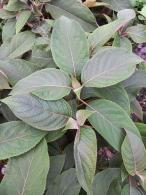Get Additional 5% Off 1st Order
Hydrangea Aspera Macrophylla
AGM Variety with Large Purple Flowerheads
1. Add items to basket
2. Go to the basket
3. Enter your postcode in Delivery Price Check
Plant shape: Bush
Pot size: 4 Litres
Plant ID: 13922 C 1
Plant shape: Bush
Pot size: 7.5 Litres
Plant ID: 14773 114
Plant shape: Bush
Pot size: 12 Litres
Plant ID: 14774 114

Hydrangea Aspera Macrophylla is an RHS AGM-winning large-leaved deciduous shrub with blue-purple flowers fringed in white. It’s a beautiful plant that suits mixed borders, plant containers and low-maintenance gardens.
Hydrangea Aspera is a large-foliaged hydrangea native to eastern Asia. Aspera is Latin for ‘rough-leaved’ which describes the foliage’s fluffy underside. This macrophylla variety has very large leaves up to 28 cms in length that emerge bright green in spring. They are followed by large flat showy flowerheads in early summer. The flowerheads are bluey-lilac in the centre but are surrounded by delicate white florets.
In winter all the foliage and flowers fall and grow back stronger and better the following year.
This is a well-loved and very popular showpiece hydrangea that instantly brightens a garden or roof terrace / balcony with glorious colour and luscious big leaves.
Height And Spread of Hydrangea Aspera Macrophylla
Over 10-20 years Hydrangea Macrophylla will reach a height and spread of 2.5 metres.
How Hardy Is Hydrangea Aspera Macrophylla
This is a hardy hydrangea capable of withstanding cold UK winters if its roots are well drained.
How To Use Hydrangea Aspera Macrophylla
Hydrangea Macrophylla is a stunning addition to a mixed flower bed in an urban garden or country cottage-style planting. It’s a real eye-catcher and instantly recognisable. It also thrives in large well-watered containers on sheltered balconies and decking.
The large flowers are long-lasting in arrangements and the skeletal dried heads can last for years indoors.
How To Care For Hydrangea Aspera Macrophylla
Hydrangea Macrophylla is easy to grow and low maintenance despite its showy flowers and foliage.
Choose a sheltered spot in full sun or partial shade. This hydrangea prefers neutral to acidic soil, so if yours is very alkaline use plenty of acid-based compost and top it up with bracken or pine-based mulch each year. If the leaves start to yellow, it’s best to put it in a container of ericaceous compost.
It doesn’t require pruning, but a can of water in very dry spells is appreciated. Raise container-grown hydrangea up on feet to aid drainage and feed them with a specialist hydrangea fertiliser throughout the growing months.












